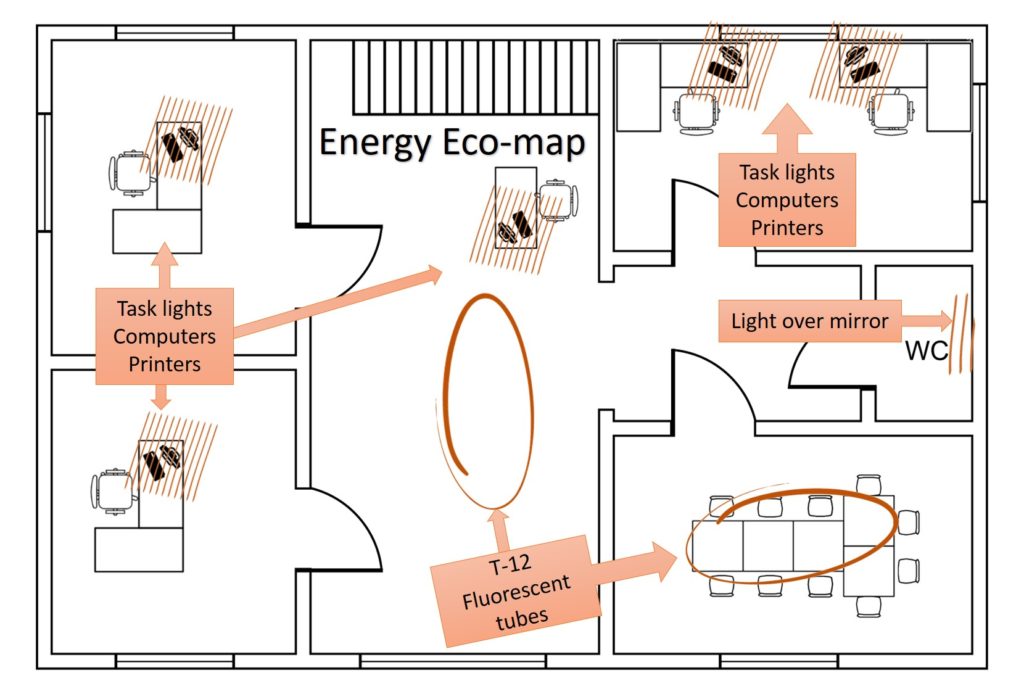What is it? How can it help you save money, improve your operations, and feel good doing it.
Introduction
Eco-mapping is an amazingly simple and effective method of doing a quick facility environmental review. It allows you to visualize areas of your workplace that need the most help to reduce your impact, often saving money at the same time.
How to do it
Step 1. Get a copy of your workplace floor plan. If you have an emergency exit plan, you can use that. Label the rooms and identify key features. For example, if you are looking at energy use, point out banks of fluorescent tubes, computers, copy machines, refrigerators, microwave ovens, and other energy users. If you are looking at water, point out sinks, toilets, irrigation, etc. If waste, identify recycling, large trash bins, and other areas of waste storage. These can be fairly general rather than detailed – that is, you don’t have to identify every fluorescent tube – just the ceiling area where they are. (There are other environmental checklists that involve counting specific equipment and fixtures – we’ll talk about those at another time.)
Step 2. Pick an environmental impact (energy, water, waste, or other impact – more on those other impacts later in this blog).
Step 3. Walk through your workplace with the floorplan. Identify places using or, potentially, wasting the resource you’ve chosen to check. Put hash marks in areas that have minor impact. Circle the areas that are a major problem – the bigger the problem, the heavier the circle. Label the problems.

Step 4. (optional) If you have the ability to create a digital version, make it as visual and clear as possible. One approach is to scan your emergency exit map into a JPG, insert into a PowerPoint slide, and use circles and multiple lines to identify areas with major and minor impact. Download the Eco-Mapping guidelines for an example. These guidelines include some icons you can copy and paste for your own use in your digital eco-map.
Tracking major and minor waste and use
There are a number of impacts you can track using eco-maps. Most of you could identify the usefulness of tracking energy, water, and waste – the three traditional, major impacts we work to reduce. However, you can also use eco-maps to track minor, but annoying, impacts, such as transportation, packaging, nuisance, noise, odors, land use, and other raw materials use. Once you draw the eco-maps, you need to label and document the impacts, estimate the amounts or size of the impact or collect specific data on each impact (there are other checklists that can help you with this).
Putting it all together to find solutions
If you do several eco-maps, putting them together on one map can help you identify and prioritize areas to improve.
This is pretty easy with a digital version, because you can do a slide or page for each map, and then create another slide with a blank map and copy/paste the circles and hash marks from each map onto this fresh map, color coding the icons for each issue, e.g., blue for water use/leaks, red for energy use, green for waste, black or brown for noise, dust, or other impacts.
Don’t want to hassle with creating a digital version? You can mark multiple resources on the same map, or you can use old-timey transparencies (remember those?) to create layers of resource use and waste on a blank map.
Why do this?
Remember, every resource your business uses costs money, and you will likely achieve a synergistic effect on people, planet and profit as a result of your improvements. Even on people? Yes! Research shows people feel good when they work for a company that is more sustainable – it buys loyalty and reduces turnover.
Take Action
With the information you have from your eco-maps, you can develop an action plan to address your findings. Where can you reduce your impact? Are there low-cost equipment or fixture changes you can make (e.g., aerators for sinks, LED bulbs, repurposing or recycling more types of waste)? Or, would minor behavior changes make a major impact? Create a to-do list with firm dates to make a difference in your resource use and waste. Or, develop a sustainable strategic plan, with SMART (Specific, Measurable, Actionable, Relevant, and Time-based) goals, improvement projects, and metrics to confirm your plan is working. Then, watch for the difference in your bottom line!
We will be discussing many of these options in future blogs.
References:
Engel, H-W. (1998) Ecomapping. Translated into English by Claire Buckley, INEM. Adapted by SBA,2002. https://sba-int.ch/publications/
Related posts
